Showing posts with label Beijing. Show all posts
Showing posts with label Beijing. Show all posts
Tuesday, September 16, 2014
Wednesday, August 22, 2007
China: Last day in Beijing
 Yesterday was my last day in Beijing. In the morning, we had our closing ceremonies at the China National Institute of Cultural Property. I was asked to give a speech in behalf of all Asian countries present and blurted out a few Chinese lines I practiced the night before. They gave us our certificates and really nice tokens. A lunch banquet followed and it would not be complete without the traditional Chinese toast "Gan bei!" which means "Bottoms up!"
Yesterday was my last day in Beijing. In the morning, we had our closing ceremonies at the China National Institute of Cultural Property. I was asked to give a speech in behalf of all Asian countries present and blurted out a few Chinese lines I practiced the night before. They gave us our certificates and really nice tokens. A lunch banquet followed and it would not be complete without the traditional Chinese toast "Gan bei!" which means "Bottoms up!" In the afternoon, I met up with my SSEAYP batchmates Pam and Edwin who were in Beijing for the 2nd China-ASEAN Youth Camp (I was a delegate during the 1st CAYC last year). What a coincidence that my schedule coincided with this year's camp.
In the afternoon, I met up with my SSEAYP batchmates Pam and Edwin who were in Beijing for the 2nd China-ASEAN Youth Camp (I was a delegate during the 1st CAYC last year). What a coincidence that my schedule coincided with this year's camp.We met at the Beijing Olypics Countdown Clock in Tian'anmen Square and proceeded to Houhai/Shichahai from there. Houhai is famous for its nightlife and chic bars and restaurants by the lake. I joined them back to their hotel because I wanted to meet Wu Wei of the All-China Youth Federation.
 He invited me for drinks so we went back to Houhai. We took a cab since Wu Wei said he could not drink with me if he brought his car. Now that is being responsible!
He invited me for drinks so we went back to Houhai. We took a cab since Wu Wei said he could not drink with me if he brought his car. Now that is being responsible!Even on weekdays, the place is teeming with people. Nightlife is indeed alive in Houhai! And there were so many choices. We finally went to Lotus Blue Bar & Restaurant, downed half a case of Carlsberg there and played a dice game popular in bars to determine who drinks. It was all fun for my last night in Beijing! Photos are in Multiply.
So where's the apology?
While I was in China, an article by Malu Fernandez was e-mailed to me. When I got back, I realized the issue had been raging in the Internet for days. As a travel writer, I am unimpressed with her article. It does not give readers a sense of place of where she's been. Who cares if you used gold, open-toed sandals to climb the Acropolis? It's pathetic that the Hellenic attractions were only mentioned in passing. As a Filipino, I am appalled. How dare you call this country God-forsaken! You've even insulted your own countrymen.
If you want to read reactions to Malu's articles, simply type "Malu Fernandez" in Google. Trust me, they can get really nasty and I'm sure they'd give any reader a good laugh. I hope she learned her lesson. But everyone is waiting for her apology. And until she gives it, I don't think we will hear the last of this Malu Fernandez fiasco. I join the blogging community in expressing my indignation.
Technorati Tags: beijing, china, heritage, architecture, travel, travel+blog
Wednesday, August 08, 2007
China: One year countdown to the Beijing Olympics begins
 On 8:08 p.m. of 08/08/08 (August 8, 2008), the 2008 Beijing Olympics will begin. It’s one big party in Beijing today as China and the world counts 365 days to the opening of the Games of the XXIXth Olympiad. I was planning to join the party in Tian’anmen Square but ended up watching the ceremonies on TV instead.
On 8:08 p.m. of 08/08/08 (August 8, 2008), the 2008 Beijing Olympics will begin. It’s one big party in Beijing today as China and the world counts 365 days to the opening of the Games of the XXIXth Olympiad. I was planning to join the party in Tian’anmen Square but ended up watching the ceremonies on TV instead.I was in the center of Beijing today for a change in routine. It took me quite a while to get there from my hotel which is along the North 4th Ring East Road near the construction area of the National Olympic Center (I should check that out one of these days). The hotel is about a kilometer from the nearest subway station.
 First stop was the Philippine Embassy to meet up with my brod who is consul general in Beijing. We had lunch at Friday’s (after having Chinese food three times a day everyday for the past week, one craves for a change).
First stop was the Philippine Embassy to meet up with my brod who is consul general in Beijing. We had lunch at Friday’s (after having Chinese food three times a day everyday for the past week, one craves for a change).After lunch, I took a subway to Tian’anmen Square. I had wanted to check out the countdown clock again but the whole square was cordoned off in preparation for the program in the evening. Oh well! There goes my revisit to Chairman Mao’s mausoleum.
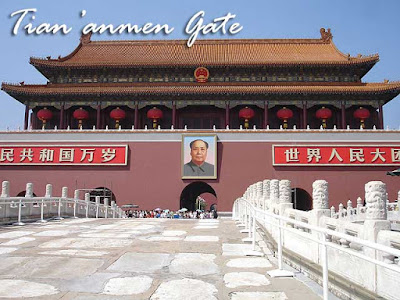 Crowds were already waiting along the sides of Tian’anmen. There were even people passing the time in the pedestrian underpasses since it was so humid outside. I walked towards Qianmen and from there, took the subway to Liulichang Cultural Street.
Crowds were already waiting along the sides of Tian’anmen. There were even people passing the time in the pedestrian underpasses since it was so humid outside. I walked towards Qianmen and from there, took the subway to Liulichang Cultural Street. Known for its cultural stores housed in restored old shop houses, Liulichang is a must-visit if you like the feel of old streets or like collecting antiques or art. You can find a lot of antique stores, calligraphy and art galleries, bookstores, tea houses and small shops selling miscellaneous cultural stuff (but no commercial souvenirs like those in Sichahai). Just like always, bargain hard. I got myself some really nice ceramic figurines for one-third the original price (I feel I could have gotten them even lower).
Known for its cultural stores housed in restored old shop houses, Liulichang is a must-visit if you like the feel of old streets or like collecting antiques or art. You can find a lot of antique stores, calligraphy and art galleries, bookstores, tea houses and small shops selling miscellaneous cultural stuff (but no commercial souvenirs like those in Sichahai). Just like always, bargain hard. I got myself some really nice ceramic figurines for one-third the original price (I feel I could have gotten them even lower). Exhausted by the humidity, I decided to make my way back to the hotel. Beijing is just so big, I’m getting so much exercise from the long walks. One more day of lectures before we fly to Guilin for the weekend. I heard it’s really nice.
Exhausted by the humidity, I decided to make my way back to the hotel. Beijing is just so big, I’m getting so much exercise from the long walks. One more day of lectures before we fly to Guilin for the weekend. I heard it’s really nice.Technorati Tags: beijing, china, heritage, acrhitecture, tiananmen square, olympics, travel, travel blog
Sunday, August 05, 2007
China: Around old Beijing
 I wasn’t that excited today maybe because I was at the Forbidden City just last October. It was also a Sunday, and I was expecting a large crowd and I hate going around heritage sites when they are crowded.
I wasn’t that excited today maybe because I was at the Forbidden City just last October. It was also a Sunday, and I was expecting a large crowd and I hate going around heritage sites when they are crowded. My expectations were not unfounded. There were just too many people and you had to jostle your way to see the different areas of the Forbidden City. Add to the fact that many of the major buildings were undergoing restoration and still covered by scaffolding. I was hoping restoration works on the main palace was finished by now since it was also covered last year. But it was not yet completed. So I just made good use of my time and strolled around the palace complex.
My expectations were not unfounded. There were just too many people and you had to jostle your way to see the different areas of the Forbidden City. Add to the fact that many of the major buildings were undergoing restoration and still covered by scaffolding. I was hoping restoration works on the main palace was finished by now since it was also covered last year. But it was not yet completed. So I just made good use of my time and strolled around the palace complex. Like yesterday, we had lunch in the bus. They took us to the Yashow Clothing Market in the afternoon but that did not interest me (as a general rule, if it’s something I can buy easily in the Philippines, I won’t buy it). So I asked permission from the organizers to separate from the group. Boris from Serbia joined me to Beihai (North Lake) Park which I had wanted to see during my trip last year. We took a taxi from the market to Beihai which was RMB20 (PHP140). Had I known it was a clothing market, I would have stayed behind at the Forbidden City since many of the historical sites are nearby. Entrance to the park is RMB20.
Like yesterday, we had lunch in the bus. They took us to the Yashow Clothing Market in the afternoon but that did not interest me (as a general rule, if it’s something I can buy easily in the Philippines, I won’t buy it). So I asked permission from the organizers to separate from the group. Boris from Serbia joined me to Beihai (North Lake) Park which I had wanted to see during my trip last year. We took a taxi from the market to Beihai which was RMB20 (PHP140). Had I known it was a clothing market, I would have stayed behind at the Forbidden City since many of the historical sites are nearby. Entrance to the park is RMB20. Beihai Park was part of the imperial gardens. If not for the large weekend crowd, the stroll around would have been very refreshing with its large picturesque lake full of lotus plants in full-bloom and hundreds of trees. As they say, the garden has the dignity of the northern style and the exquisiteness of the southern style. Maybe I could come back on a weekday to absorb the scenery.
Beihai Park was part of the imperial gardens. If not for the large weekend crowd, the stroll around would have been very refreshing with its large picturesque lake full of lotus plants in full-bloom and hundreds of trees. As they say, the garden has the dignity of the northern style and the exquisiteness of the southern style. Maybe I could come back on a weekday to absorb the scenery. In the middle of the lake is Qiong Island linked by two old bridges. The island has a hill with several temples and shrines, and an imposing white Tibetan-style dagoba on top. From the top, you could see the entire Forbidden City and other old structures in the vicinity. Sadly, the weather did not cooperate with us. Since it was foggy, visibility was low.
In the middle of the lake is Qiong Island linked by two old bridges. The island has a hill with several temples and shrines, and an imposing white Tibetan-style dagoba on top. From the top, you could see the entire Forbidden City and other old structures in the vicinity. Sadly, the weather did not cooperate with us. Since it was foggy, visibility was low.We walked several hundred meters towards the north gate of the park to get to Sichahai for a rickshaw tour of the hutongs. I was there last year but it was in the evening. So I was not able to appreciate the hutong tour that much. Hutongs are the alleyways which typified old Beijing.
 Outside the palace, princes, civil servants, wealthy merchants and other common folk lived in these hutongs. There are just a few of them left as many of them were bulldozed to give way to new developments. But the Beijing government put a stop to the demolition and preserved a large part of the hutongs close to the Forbidden City as a reminder of life before. Sooner or later, cities realize that preserving heritage is vital for their growth and development. And I hope local officials in the Philippines realize it sooner while there is still something left to preserve.
Outside the palace, princes, civil servants, wealthy merchants and other common folk lived in these hutongs. There are just a few of them left as many of them were bulldozed to give way to new developments. But the Beijing government put a stop to the demolition and preserved a large part of the hutongs close to the Forbidden City as a reminder of life before. Sooner or later, cities realize that preserving heritage is vital for their growth and development. And I hope local officials in the Philippines realize it sooner while there is still something left to preserve. One of the places we visited was the 300-year old Beijing courtyard style home of the Qi family (5 QianGan Hutong), which is one of a few well-preserved private courtyards open to the public (RMB20). One could see the development of the city’s hutongs by visiting these all-gray homes which are still in use. It amazes me how local and foreign tourists visited these alleyways in droves. And residents charge for entrance into their traditional homes. Imagine this happening in old Manila districts such as (Hidalgo Street) Quiapo, San Nicolas and San Miguel.
One of the places we visited was the 300-year old Beijing courtyard style home of the Qi family (5 QianGan Hutong), which is one of a few well-preserved private courtyards open to the public (RMB20). One could see the development of the city’s hutongs by visiting these all-gray homes which are still in use. It amazes me how local and foreign tourists visited these alleyways in droves. And residents charge for entrance into their traditional homes. Imagine this happening in old Manila districts such as (Hidalgo Street) Quiapo, San Nicolas and San Miguel.While in Sichahai, don’t forget to check out Yandai Byway to shop for souvenirs such as Mao memorabilia, silk and traditional clothing, tea (although prices are outrageous), Chinese cultural items, as well as the usual tourist stuff like magnets, key chains, trinkets, etc.
 I didn’t buy anything since I wanted to reserve all my shopping towards the end of the seminar. But make sure you bargain hard since they overprice the items beyond comprehension. Don’t think an amount is too low because if you turn away, they might just say yes. I asked the price of a Buddha image and they said RMB260. I didn’t budge. Their asking price went lower but not that much. I said RMB50 and they laughed. When I left, they ran after me and said “Ok, ok, RMB50!” But I said I’m no longer interested and I’ll think about it. Who knows, I could have gone lower.
I didn’t buy anything since I wanted to reserve all my shopping towards the end of the seminar. But make sure you bargain hard since they overprice the items beyond comprehension. Don’t think an amount is too low because if you turn away, they might just say yes. I asked the price of a Buddha image and they said RMB260. I didn’t budge. Their asking price went lower but not that much. I said RMB50 and they laughed. When I left, they ran after me and said “Ok, ok, RMB50!” But I said I’m no longer interested and I’ll think about it. Who knows, I could have gone lower.From Sichahai, we walked towards the Drum and Bell Towers. I had seen these towers last year but in the evening. So I wanted to see them up close while the sun was still out. From there, we walked towards the subway station and took a train back to our hotel in the northeastern area of Beijing, just in time for dinner.
Related articles
Finding heritage value
Three years after Unesco's World Heritage Center released a scathing report on the country's poor management of its cultural sites, boom-time China is starting to realize that preserving archaeological finds can be more lucrative than developing shopping malls.
Technorati Tags: beijing, china, forbidden city, hutongs, unesco, heritage, architecture, travel, travel blog
Saturday, August 04, 2007
China: Back in Beijing
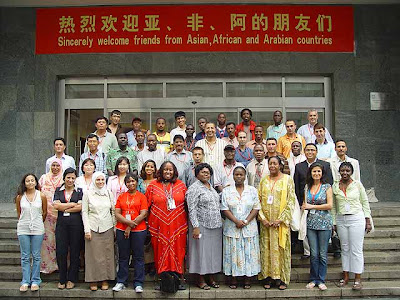 I can't believe I'm back in Beijing in less than a year! I'm attending the Seminar on Conservation and Management of Cultural Heritage for Asian and African Countries organized by the China National Institute of Cultural Property (CNICP) from August 1 to 15. However, I arrived a day late because of the GMA event last August 1.
I can't believe I'm back in Beijing in less than a year! I'm attending the Seminar on Conservation and Management of Cultural Heritage for Asian and African Countries organized by the China National Institute of Cultural Property (CNICP) from August 1 to 15. However, I arrived a day late because of the GMA event last August 1.I was hoping to see more ASEAN countries here but it's just me and the two delegates from Myanmar. There are some from the former Soviet Union such as Azerbaijan, Armenia and Turkmenistan, as well as Nepal (South Asia) and Mongolia (East Asia). But most of the delegates are from Africa. There are also some Arab delegates attending another seminar.
 As always, we're being served several courses for breakfast, lunch and dinner. And at the rate I'm going, I might gain more weight. Sigh! Most of our time will be in sessions at the CNICP. But on weekends, the group will go on educational trips.
As always, we're being served several courses for breakfast, lunch and dinner. And at the rate I'm going, I might gain more weight. Sigh! Most of our time will be in sessions at the CNICP. But on weekends, the group will go on educational trips.  Today, I was back at the Ming Tombs and the Great Wall of China, both UNESCO World Heritage Sites. Good thing they brought us to those I have not yet seen. Last year, I was at Zhao Ling and the Great Wall section at Badaling. This time, we visited Ding Ling, the mausoleum of the 13th emperor of the Ming Dynasty Zhu Yijun and his two empresses. It was completed in 1590. We got to visit it's underground palace (burial chamber) since this was the first of the thirteen tombs to be excavated (only three have been unearthed to date). There was a museum built near the entrance which features all the treasures they found in the underground palace.
Today, I was back at the Ming Tombs and the Great Wall of China, both UNESCO World Heritage Sites. Good thing they brought us to those I have not yet seen. Last year, I was at Zhao Ling and the Great Wall section at Badaling. This time, we visited Ding Ling, the mausoleum of the 13th emperor of the Ming Dynasty Zhu Yijun and his two empresses. It was completed in 1590. We got to visit it's underground palace (burial chamber) since this was the first of the thirteen tombs to be excavated (only three have been unearthed to date). There was a museum built near the entrance which features all the treasures they found in the underground palace. We had lunch in the bus before proceeding to Juyongguan Pass which is the section of the Great Wall nearest to Beijing. What is unique about this section are its fortified gates.
We had lunch in the bus before proceeding to Juyongguan Pass which is the section of the Great Wall nearest to Beijing. What is unique about this section are its fortified gates. Since it looked like it was going to rain (and it did), I decided not to go to far up. I was able to explore the walls on both sides of the gate. In front of the gate, I was also able to get on a camel for a photo. We got back at the hotel at about 4 p.m. which gave us two hours to rest before dinner was served. Tomorrow, I will be back in the Forbidden City. More photos is Multiply.
Since it looked like it was going to rain (and it did), I decided not to go to far up. I was able to explore the walls on both sides of the gate. In front of the gate, I was also able to get on a camel for a photo. We got back at the hotel at about 4 p.m. which gave us two hours to rest before dinner was served. Tomorrow, I will be back in the Forbidden City. More photos is Multiply.Technorati Tags: beijing, china, great wall, ming tombs, unesco, heritage, architecture, travel, travel blog
Friday, November 03, 2006
China: The Summer Palace, an imperial garden in Beijing
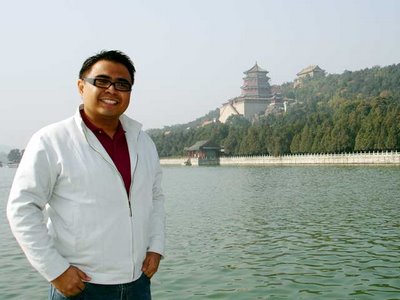 Today was our last day in Beijing. My two companions were leaving for Guangzhou at 1 p.m. So they had to prepare for the 22 hour train trip back. Marlon did some last minute shopping and was up really early. My train for Shanghai was leaving at 7 p.m. so I still had time for one more attraction. And today, I was scheduled to visit my fifth UNESCO World Heritage Site in Beijing, the Summer Palace.
Today was our last day in Beijing. My two companions were leaving for Guangzhou at 1 p.m. So they had to prepare for the 22 hour train trip back. Marlon did some last minute shopping and was up really early. My train for Shanghai was leaving at 7 p.m. so I still had time for one more attraction. And today, I was scheduled to visit my fifth UNESCO World Heritage Site in Beijing, the Summer Palace.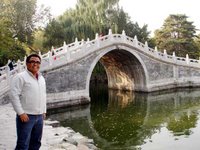 Known as Yiheyuan (頤和園), which literally means "Garden of Nurtured Harmony," the Summer Palace was first built in 1750 as the Qingyiyuan (清漪園) or Garden of Clear Ripples. However, it was ransacked in 1860 by British and French forces, together with the old Summer Palace, the Yuanmingyuan (圓明園). The Yuanmingyuan was totally destroyed but the Qingyiyuan survived.
Known as Yiheyuan (頤和園), which literally means "Garden of Nurtured Harmony," the Summer Palace was first built in 1750 as the Qingyiyuan (清漪園) or Garden of Clear Ripples. However, it was ransacked in 1860 by British and French forces, together with the old Summer Palace, the Yuanmingyuan (圓明園). The Yuanmingyuan was totally destroyed but the Qingyiyuan survived.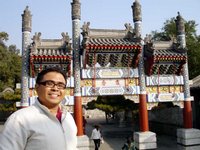 The current palace was rebuilt in 1886 by the Empress Dowager Cixi who diverted 30 million taels of silver meant for the Chinese navy to finance its construction. Cixi used it as her summer resort. It was christened Yiheyuan in 1888. In 1900, during the Boxer Rebellion, it was again damaged by an eight-nation allied invasion but survived. It was again reconstructed in 1902.
The current palace was rebuilt in 1886 by the Empress Dowager Cixi who diverted 30 million taels of silver meant for the Chinese navy to finance its construction. Cixi used it as her summer resort. It was christened Yiheyuan in 1888. In 1900, during the Boxer Rebellion, it was again damaged by an eight-nation allied invasion but survived. It was again reconstructed in 1902. Taking the cab was out of the question since the Summer Palace was quite a distance from the center of Beijing. I was told it was about 50 minutes by bus. For some reason, I was planning to leave at 8 a.m. but the next thing I knew, it was already 10 a.m. Hehe! Anyway, I was able to ask around which bus to take to the Yiheyuan and waitied at the bus stop. Just to be sure, I looked for the Chinese characters for Yiheyuan on the bus route posted at the stop and it turns out, the Summer Palace was the last stop of the bus. The cost of the bus was RMB5.
Taking the cab was out of the question since the Summer Palace was quite a distance from the center of Beijing. I was told it was about 50 minutes by bus. For some reason, I was planning to leave at 8 a.m. but the next thing I knew, it was already 10 a.m. Hehe! Anyway, I was able to ask around which bus to take to the Yiheyuan and waitied at the bus stop. Just to be sure, I looked for the Chinese characters for Yiheyuan on the bus route posted at the stop and it turns out, the Summer Palace was the last stop of the bus. The cost of the bus was RMB5. I finally arrived at the East Palace Gate of the Summer Palace after a long trip into the Beijing suburbs. I thought I could finish touring around in three hours but I under estimated its size since I found out that the complex covers an area of 290 hectares! So it was impossible to finish it before 3 p.m., the time I set for me to troop back to the city center to catch my train.
I finally arrived at the East Palace Gate of the Summer Palace after a long trip into the Beijing suburbs. I thought I could finish touring around in three hours but I under estimated its size since I found out that the complex covers an area of 290 hectares! So it was impossible to finish it before 3 p.m., the time I set for me to troop back to the city center to catch my train.The through ticket to the Summer Palace is RMB50. I also bought an English map of the place at RMB5 if I'm not mistaken. So I started my trek around the palace. There was no straight route to visit all the important structures since they were scattered around Kunming Lake and Longevity Hill.
 As soon as I entered, a structure covered in scaffolding welcomed me. Yikes! I hoped this was the only one being restored. It turns out it was the only one since restoration on many of the Summer Palace buildings had already been completed. I first dropped by the Garden of Virtue and Harmony which was built as a theater for Cixi. Inside is the Grand Stage (left), a three-storey theater stage which is the largest and best-preserved wooden stage in China, and is considered the "Cradle of Beijing Opera." Behind it is a two-storey make-up room which is now a showroom of Cixi's carriages and automobile, believed to be the first car imported into China.
As soon as I entered, a structure covered in scaffolding welcomed me. Yikes! I hoped this was the only one being restored. It turns out it was the only one since restoration on many of the Summer Palace buildings had already been completed. I first dropped by the Garden of Virtue and Harmony which was built as a theater for Cixi. Inside is the Grand Stage (left), a three-storey theater stage which is the largest and best-preserved wooden stage in China, and is considered the "Cradle of Beijing Opera." Behind it is a two-storey make-up room which is now a showroom of Cixi's carriages and automobile, believed to be the first car imported into China. From there, I tried to walk towards the Seventeen-arch Bridge but it was quite far and I didn't have enough time. So I took a photo with Kunming Lake (昆明湖) and Longevity Hill (万寿山) as a background and then trekked towards the Tower of the Fragrance of the Buddha which was on top of the hill. Also bought some dumplings for a quick lunch. On the way to the hill, you would walk through the Long Corridor (长廊), which at 728 meters is reputedly the longest corridor in the world.
From there, I tried to walk towards the Seventeen-arch Bridge but it was quite far and I didn't have enough time. So I took a photo with Kunming Lake (昆明湖) and Longevity Hill (万寿山) as a background and then trekked towards the Tower of the Fragrance of the Buddha which was on top of the hill. Also bought some dumplings for a quick lunch. On the way to the hill, you would walk through the Long Corridor (长廊), which at 728 meters is reputedly the longest corridor in the world.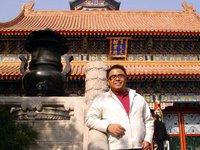 Welcoming you up the hill was the Hall that Dispels the Clouds or Paiyun Dian (left) which was built to celebrate Cixi's birthday. Inside were birthday gifts given to her by princes, dukes and high-ranking officials. I would have wanted to go up to the tower which housed a five-meter high gilded bronze statue of the Guanyin Bodhisattva cast in 1574; but time was against me. I still had a long walk and just an hour and a half left to go around. So I continued walking.
Welcoming you up the hill was the Hall that Dispels the Clouds or Paiyun Dian (left) which was built to celebrate Cixi's birthday. Inside were birthday gifts given to her by princes, dukes and high-ranking officials. I would have wanted to go up to the tower which housed a five-meter high gilded bronze statue of the Guanyin Bodhisattva cast in 1574; but time was against me. I still had a long walk and just an hour and a half left to go around. So I continued walking. Another attraction was the famous Marble Boat (石舫) also known as the Clear and Peaceful Boat. This 36-meter two-storey boat was carved out of a shadowy blue stone. It was a symbol of stability ofthe Qing Dynasty, an idea derived from the saying "Water can carry a boat, and it can also capsize a boat," serving as a warning to the emperor that he had to attend to state affairs with prudence.
Another attraction was the famous Marble Boat (石舫) also known as the Clear and Peaceful Boat. This 36-meter two-storey boat was carved out of a shadowy blue stone. It was a symbol of stability ofthe Qing Dynasty, an idea derived from the saying "Water can carry a boat, and it can also capsize a boat," serving as a warning to the emperor that he had to attend to state affairs with prudence. I was planning to exit via the North Palace Gate and it was still quite far. I passed by some trees which displayed autumn's colors but not as spledid as those we saw on the way to the Great Wall yesterday.
I was planning to exit via the North Palace Gate and it was still quite far. I passed by some trees which displayed autumn's colors but not as spledid as those we saw on the way to the Great Wall yesterday.Also on the way were some nice bridges and more old structures until I finally reached the Hall of the Buddha Confirming His Docrine, a temple which housed gargantuan statues of the Buddha and various Buddhist saints.
My last stop was Suzhou Street, a famous shopping street in the imperial gardens, imitating the shops along the canal in Suzhou. It was first built in 1751 and completely destroyed in 1860. The Chinese government totally rebuilt all the structures based on photos in 1991. The street is now an impressive assemblage of old shop houses. I hope they do this as well along the canals of Binondo since we have a lot of old photos of this charming area of Manila.
 I wasn't able to walk the entire area of Suzhou Street since it was already 3 p.m. and since it would take a while to get back to the city center, I decided to catch a bus. Outside was the stop for bus no. 808 which would take me to Tian'anmen Square. Again, the fare was RMB5. The trip was longer this time since traffic was heavy. The bus left at 3:30 p.m. and we were back in the city center at 5:15 p.m.
I wasn't able to walk the entire area of Suzhou Street since it was already 3 p.m. and since it would take a while to get back to the city center, I decided to catch a bus. Outside was the stop for bus no. 808 which would take me to Tian'anmen Square. Again, the fare was RMB5. The trip was longer this time since traffic was heavy. The bus left at 3:30 p.m. and we were back in the city center at 5:15 p.m. Since I didn't want to miss my train, I opted to take a cab back to the hotel to get my luggage and bring me straight to the train station. I arrived there at 6 p.m. which gave me just enough time to buy some dinner and then board the train to Shanghai. The trip was 12 hours and I was arriving in Shanghai at 7 a.m.
Since I didn't want to miss my train, I opted to take a cab back to the hotel to get my luggage and bring me straight to the train station. I arrived there at 6 p.m. which gave me just enough time to buy some dinner and then board the train to Shanghai. The trip was 12 hours and I was arriving in Shanghai at 7 a.m.Thursday, November 02, 2006
China: Sichahai and the hutongs of Beijing
 What I thought was Beihai Park was actually Sichahai. I think I got my directions wrong so instead of going south towards Beihai, I walked north. As I entered, a group of rickshaw drivers started to pester me. They were showing me a map and saying that it was too far to walk. And that they would take me around the sites. I pretended not to be interested and from RMB180 which is the price in the map, they offered to take me around for an hour for RMB50.
What I thought was Beihai Park was actually Sichahai. I think I got my directions wrong so instead of going south towards Beihai, I walked north. As I entered, a group of rickshaw drivers started to pester me. They were showing me a map and saying that it was too far to walk. And that they would take me around the sites. I pretended not to be interested and from RMB180 which is the price in the map, they offered to take me around for an hour for RMB50.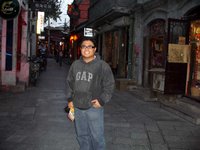 So we went around beginning in Houhai or the west bank. I did not realize it until I did some research that what I actually did was a tour of the Beijing hutongs, which are narrow maze-like lanes and alleys that were typical of Beijing communities in the olden days.
So we went around beginning in Houhai or the west bank. I did not realize it until I did some research that what I actually did was a tour of the Beijing hutongs, which are narrow maze-like lanes and alleys that were typical of Beijing communities in the olden days.Sichahai is the lakes area north of Beihai Park. You can walk around the lakes and into some of the old hutong alleys. There are also a lot of restaurants and bars along the lakes, especially in the southern tip of Qianhai called Lotus Lane.
 The driver took me to an alley with a lot of shops. I wasn't the one who wanted to go shopping but I just hit the tourist shop area of Beijing where in my opinion, the best Chinese souvenirs could be purchased at affordable prices, if you know how to bargain. I got myself an English version of Quotations from Chairman Mao Zedong (毛主席语录) which is known in the West as The Little Red Book. It is second only to the Bible in volume with over 900 million copies printed.
The driver took me to an alley with a lot of shops. I wasn't the one who wanted to go shopping but I just hit the tourist shop area of Beijing where in my opinion, the best Chinese souvenirs could be purchased at affordable prices, if you know how to bargain. I got myself an English version of Quotations from Chairman Mao Zedong (毛主席语录) which is known in the West as The Little Red Book. It is second only to the Bible in volume with over 900 million copies printed.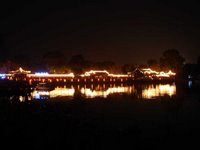 We went around more hutongs but since it was already getting dark, I wasn't able to appreciate it that much. The driver also brought me to some traditional houses which were converted into museums but I didn't want to spend for entrance which was about RMB40 each.
We went around more hutongs but since it was already getting dark, I wasn't able to appreciate it that much. The driver also brought me to some traditional houses which were converted into museums but I didn't want to spend for entrance which was about RMB40 each.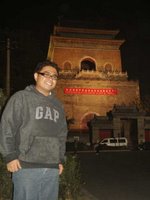 When the tour ended, I took a walk again in Sichahai, this time along Lotus Lane which was flooded in lights (above right). The restaurants looked very appealing but again, I was on a very tight budget so I decided to have dinner elsewhere. I saw a structure from a distance and it turned out to be the Drum Tower or Gulou. So I walked towards it.
When the tour ended, I took a walk again in Sichahai, this time along Lotus Lane which was flooded in lights (above right). The restaurants looked very appealing but again, I was on a very tight budget so I decided to have dinner elsewhere. I saw a structure from a distance and it turned out to be the Drum Tower or Gulou. So I walked towards it.Right beside the Drum Tower was the Bell Tower or Zhonglou (left). It was quite difficult to get a good shot of the Drum Tower in the evening since it was quite massive and there was no good angle to shoot from. But I got a photo of the Bell Tower. Hehe!
 I found myself on a shopping street and decided to keep walking southwards towards the hotel. Along the way, I found dinner! It was siopao! Haha! There were different kinds such as those stuffed with pork, and the rest were stuffed with various vegetables and tofu. I don't think we have vegetable-stuffed siopao in the Philippines. The clincher here was that each piece was just RMB0.80 or roughly PHP5 each! Now that was a cheap dinner. Haha!
I found myself on a shopping street and decided to keep walking southwards towards the hotel. Along the way, I found dinner! It was siopao! Haha! There were different kinds such as those stuffed with pork, and the rest were stuffed with various vegetables and tofu. I don't think we have vegetable-stuffed siopao in the Philippines. The clincher here was that each piece was just RMB0.80 or roughly PHP5 each! Now that was a cheap dinner. Haha!Since I was already tired from walking, I decided to take a taxi back to the hotel. I was already prepared to sleep when Rhea and Marlon found out about Sichahai. So I agreed to go back with them to show them the place so they could shop for more souvenirs.
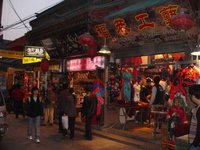 While we were checking out the shops, I saw a sign which said foot massage for just RMB38. And since my feet were aching, I could not resist. When we got back to the hotel, I went straight to bed.
While we were checking out the shops, I saw a sign which said foot massage for just RMB38. And since my feet were aching, I could not resist. When we got back to the hotel, I went straight to bed.China: The Great Wall of China
 We had to get up early today for our visit to the Great Wall of China (萬里長城). The day before, we booked seats with the travel agent in our hotel for a package tour to the Great Wall and Ming Tombs (明朝十三陵). The price was RMB150 which we felt was a good deal since it included transportation, entrance to the sites, and lunch.
We had to get up early today for our visit to the Great Wall of China (萬里長城). The day before, we booked seats with the travel agent in our hotel for a package tour to the Great Wall and Ming Tombs (明朝十三陵). The price was RMB150 which we felt was a good deal since it included transportation, entrance to the sites, and lunch.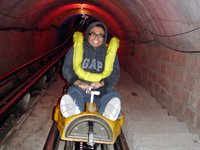 There were optional fees which included RMB60 for a slide car ride up the mountain and down back; as well as RMB40 for extra sites which we could not get the agency to explain in English. So we opted for the slide car ride. Another option up the mountain was a cable car ride but the tour they offered did not have that option since the drop off point for the cable car was in another part of the Great Wall.
There were optional fees which included RMB60 for a slide car ride up the mountain and down back; as well as RMB40 for extra sites which we could not get the agency to explain in English. So we opted for the slide car ride. Another option up the mountain was a cable car ride but the tour they offered did not have that option since the drop off point for the cable car was in another part of the Great Wall. Anyway, the bus passed by for us in the hotel at 7:15 a.m. and there were already other passengers. The sad thing was the guide was speaking in Chinese since it turns out, we were the only foreigners on the bus.
Anyway, the bus passed by for us in the hotel at 7:15 a.m. and there were already other passengers. The sad thing was the guide was speaking in Chinese since it turns out, we were the only foreigners on the bus.On the way, one of the passengers started a shouting match with the guide. We had figured that it had something to do with the payment since the guides were doing rounds of the passengers collecting money. It turns out, the optional fees were not optional and they were collecting the said fees from those who did not pay. So that’s why one of the passengers got hysterical since she thought it was optional and didn’t want to pay for it. So we too had to pay the RMB40 which we opted not to take. Oh well!
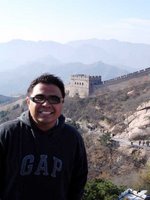 The northern pass of Juyongguan Pass is known as Badaling. This particular area of the Great Wall is the most visited by tourists. This portion of the Great Wall is 7.8 meters high and 5 meters wide.
The northern pass of Juyongguan Pass is known as Badaling. This particular area of the Great Wall is the most visited by tourists. This portion of the Great Wall is 7.8 meters high and 5 meters wide.As we neared Badaling, the view outside of the tall mountains and traces of the Great Wall was just awe-inspiring. When we exited the bus at the drop off point, a gush of frigid wind hit us. We completely forgot that it was much colder here than the city proper since we were high up in the mountains. It was so cold that I had to put on my hood to keep my ears warm. I should have purchased gloves the day before since the stalls were selling them at exorbitantly high prices. So I had to make do with the pouch in my sweater to keep my hands warm.
 The Great Wall of China (萬里長城) was built to protect the various dynasties from raids by Hunnic, Mongol, Turkic, and other nomadic tribes coming from areas in modern-day Mongolia and Manchuria. Although several walls were built since the 3rd century BC, the most famous being built between 220 BC and 200 BC by the first emperor of China, Qin Shi Huang, little of those earlier walls remain. It is the world's longest man-made structure, stretching over 6,352 kilometers. Mao Zedong had a saying: 不到長城非好漢, "You're not a hero if you haven't climbed the Great Wall."
The Great Wall of China (萬里長城) was built to protect the various dynasties from raids by Hunnic, Mongol, Turkic, and other nomadic tribes coming from areas in modern-day Mongolia and Manchuria. Although several walls were built since the 3rd century BC, the most famous being built between 220 BC and 200 BC by the first emperor of China, Qin Shi Huang, little of those earlier walls remain. It is the world's longest man-made structure, stretching over 6,352 kilometers. Mao Zedong had a saying: 不到長城非好漢, "You're not a hero if you haven't climbed the Great Wall." We boarded the slide cars up the mountain which brought us straight to the entrance of the Great Wall. This was the third UNESCO World Heritage Site I visited in just two days. I guess my high spirits just overtook me as I walked the wall and I didn’t realize I had walked a long distance already. The wall stretched as far as the eye could see. The experience was just surreal.
We boarded the slide cars up the mountain which brought us straight to the entrance of the Great Wall. This was the third UNESCO World Heritage Site I visited in just two days. I guess my high spirits just overtook me as I walked the wall and I didn’t realize I had walked a long distance already. The wall stretched as far as the eye could see. The experience was just surreal. The guides gave us an hour and a half to do our thing. Then we were off to the next destination. I thought our next stop was lunch but we were herded into a jewelry shop, and after that, a sort of food supermarket which sold vacuum-packed Peking duck, dried fruits, pastries and breads and the like. Lunch was beside the supermarket which I was not satisfied with since it was mostly rice and vegetables. So I ended up buying corn and a grilled sausage from the vendors outside.
The guides gave us an hour and a half to do our thing. Then we were off to the next destination. I thought our next stop was lunch but we were herded into a jewelry shop, and after that, a sort of food supermarket which sold vacuum-packed Peking duck, dried fruits, pastries and breads and the like. Lunch was beside the supermarket which I was not satisfied with since it was mostly rice and vegetables. So I ended up buying corn and a grilled sausage from the vendors outside.I would later read in Wikitravel a warning about tours being touted in the Forbidden City area with prices between RMB100 to 150 since these tours earned from commissions from all these outlets they bring their passengers to. Although ours was legitimate since it came from our hotel travel agency, I figured our tour was cheap since they earned if any of the passengers bought from the shops they brought us to.
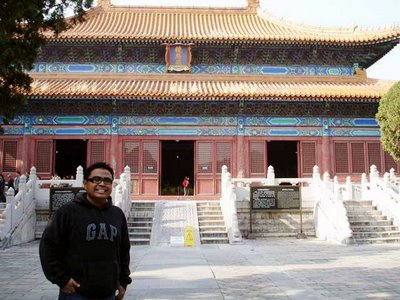 After lunch, we went to one of the Ming Tombs (明朝十三陵). There are thirteen imperial tombs of the Ming Dynasty scattered in an area of about 40 square kilometers in the Changping District of Beijing. They were inscribed in the UNESCO World Heritage List in 2003.
After lunch, we went to one of the Ming Tombs (明朝十三陵). There are thirteen imperial tombs of the Ming Dynasty scattered in an area of about 40 square kilometers in the Changping District of Beijing. They were inscribed in the UNESCO World Heritage List in 2003.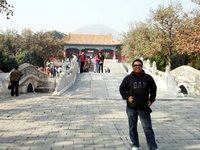 It was the Yongle Emperor, the third Ming emperor, who chose the site of the Ming Tombs. Ruling from 1402 to 1424, he was responsible for moving the capital from Nanjing to Beijing and is credited with envisioning the layout of the ancient city of Beijing. After the construction of the Forbidden City in 1420, Yongle selected his burial site and created his own mausoleum. All in all, 13 out of 16 Ming Dynasty emperors were buried in the area. The tombs of the first two Ming Emperors are located near Nanjing, the capital city during their reigns.
It was the Yongle Emperor, the third Ming emperor, who chose the site of the Ming Tombs. Ruling from 1402 to 1424, he was responsible for moving the capital from Nanjing to Beijing and is credited with envisioning the layout of the ancient city of Beijing. After the construction of the Forbidden City in 1420, Yongle selected his burial site and created his own mausoleum. All in all, 13 out of 16 Ming Dynasty emperors were buried in the area. The tombs of the first two Ming Emperors are located near Nanjing, the capital city during their reigns. Only three tombs are open to the public namely Changling, Dingling and Zhaoling. Of these, only the tumulus (underground chamber) of the Dingling Tomb has been opened. Chinese archaeologists are excited about opening the Changling tumulus housing the powerful Yongle Emperor and possibly containing the remaining copy of the Great Dictionary of Yongle (Yongle Dadian).
Only three tombs are open to the public namely Changling, Dingling and Zhaoling. Of these, only the tumulus (underground chamber) of the Dingling Tomb has been opened. Chinese archaeologists are excited about opening the Changling tumulus housing the powerful Yongle Emperor and possibly containing the remaining copy of the Great Dictionary of Yongle (Yongle Dadian).We visited the Zhaoling Tomb (昭陵) of Zhu Zaihou (朱載垕), also known as Emperor Muzong (穆宗) or the Longqing Emperor (隆慶) and his three empresses. His reign lasted only six years from1566 to 1572. It wasn't the best of the Ming Tombs though and I felt our guides were just being wise since it had the cheapest entrance fee at RMB30. As they say, "If you've seen one, you've seen them all." Hehe!
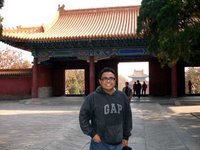 Anyway, after a brief tour of the tomb, we were back to the bus. I was expecting that the extra site was another Ming Tomb but instead they brought us to a wax museum about the Ming Dynasty. Since I’ve seen so many museums before, I would have wanted to stay in the bus and save my money but the guide refused since I think they paid a group rate. So obviously, they were also able to earn from that.
Anyway, after a brief tour of the tomb, we were back to the bus. I was expecting that the extra site was another Ming Tomb but instead they brought us to a wax museum about the Ming Dynasty. Since I’ve seen so many museums before, I would have wanted to stay in the bus and save my money but the guide refused since I think they paid a group rate. So obviously, they were also able to earn from that.But the museum was not bad since the life-size dioramas were really great and thanks to the English translations of the various scenes, I was able to learn a lot. It was just that I would have wanted to spend the RMB40 on another Ming Tomb.
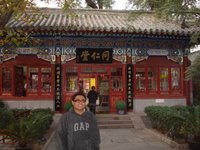 With that done, the group went back to central Beijing. I thought the tour was over but they brought us to one last stop. We went to a traditional Chinese drugstore next which was called the Beijing Tongrentang. I felt it was consistent with the Wikitravel warning. Hehe! They were giving a lecture but it was in Chinese so we were able to excuse ourselves from the sales talk which I felt they were doing in there. But the building had a lot of history since it provided medicine for royalty since 1723. It even had the golden dragon on its ceiling, a sign that it served the emperor.
With that done, the group went back to central Beijing. I thought the tour was over but they brought us to one last stop. We went to a traditional Chinese drugstore next which was called the Beijing Tongrentang. I felt it was consistent with the Wikitravel warning. Hehe! They were giving a lecture but it was in Chinese so we were able to excuse ourselves from the sales talk which I felt they were doing in there. But the building had a lot of history since it provided medicine for royalty since 1723. It even had the golden dragon on its ceiling, a sign that it served the emperor.On the way to the Tongrentang, we saw a tourist information office right beside what looked like Beihai Park. So we told the guides that we would stay behind. From there, we walked towards the office and asked some questions. Got myself a better map of Beijing. Rhea and Marlon wanted to go shopping since it was their last chance. While I wanted to check out the park. So from there, we parted ways and did our own thing.
Subscribe to:
Posts (Atom)

